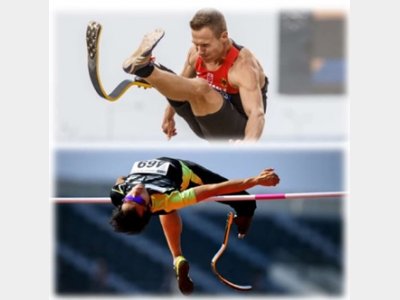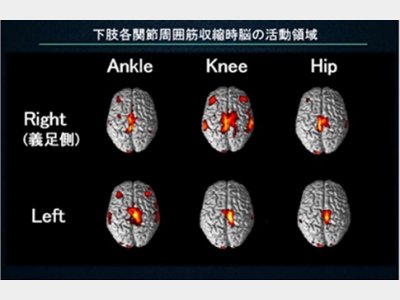Paralympic Brain ―as a model for neurorehabilitation―


Kimitaka Nakazawa
Graduate School of Arts and Sciences
Professor
Paralympic athletes may be the best role model to show the ability of the human central nervous system to reorganize itself after sustaining physical damage. Various organs in the human body, the brain in particular, have such an ability to help heal damaged parts and recover with physical training. Paralympic athletes, with no exception, have physical dysfunctions in some part of their bodies, but still they are highly motivated to improve their performance in various sports. We have found that the brains of some paralympic athletes we observed were largely reorganized after prolonged exposure to their intensive training.
Those observations have led us to a hypothesis that the combination of high motivation and intensive physical training serves as a strong drive to reorganize their brains in disability- and training-specific manner.
In this project, we aim to understand how and to what degree the brains of paralympic athletes are reorganized on both anatomical and functional fronts. We have so far observed both functional and anatomical reorganization in the brains of paralympic swimmers, amputee long jumpers and a high jumper, and power lifters, among others, by using fMRI and transcranial magnetic brain stimulation. Further studies will need to be more systematically conducted to elucidate the maximum reorganizability which human brain inherently possesses. The results of this project are expected to contribute to developing more effective rehabilitation strategies in the ever-evolving regenerative medicine field, and to extending healthy lives of elderly people.
Those observations have led us to a hypothesis that the combination of high motivation and intensive physical training serves as a strong drive to reorganize their brains in disability- and training-specific manner.
In this project, we aim to understand how and to what degree the brains of paralympic athletes are reorganized on both anatomical and functional fronts. We have so far observed both functional and anatomical reorganization in the brains of paralympic swimmers, amputee long jumpers and a high jumper, and power lifters, among others, by using fMRI and transcranial magnetic brain stimulation. Further studies will need to be more systematically conducted to elucidate the maximum reorganizability which human brain inherently possesses. The results of this project are expected to contribute to developing more effective rehabilitation strategies in the ever-evolving regenerative medicine field, and to extending healthy lives of elderly people.
Related publications
- Masugi Y, Kawashima N, Inoue D, Nakazawa K. Effects of movement-related afferent inputs on spinal reflexes evoked by transcutaneous spinal cord stimulation during robot-assisted passive stepping. Neurosci Lett (accepted)
- Nakajima T, Kamibayashi K, Kitamura T, Komiyama T, Zehr EP, Nakazawa K. Short-term plasticity in a monosynaptic reflex pathway to forearm muscles after continuous robot-assisted passive stepping. FrontNeurosci (accepted)
- Kawashima N, Nakazawa K. Effect of Aging on Postural Reflex Induced by Sudden Drop of Support Surface during Upright Standing in Humans. Frontier Bioeng Biotech-Biomech (accepted)
- Yokoyama H, Ogawa T, Kawashima N, Shinya M, Nakazawa K. Distinct sets of locomotor modules control the speed and modes of human locomotion. Sci Rep (accepted)
- Yokoyama H, Ogawa T, Kawashima N, Shinya M, Nakazawa K. Speed dependency in α-motoneuron activity and locomotor modules in human locomotion: indirect evidence for phylogenetically conserved spinal circuits. Proc Biol Sci. 2017 Mar 29;284(1851).
- Obata H, Ogawa T, Hoshino M, Fukusaki C, Masugi Y, et al. (2017) Effects of Aquatic Pole Walking on the Reduction of Spastic Hypertonia in a Patient with Hemiplegia: A Case Study. Int J Phys Med Rehabil 5:401. doi: 10.4172/2329-9096.1000401
- Masugi Y, Inoue D, Kawashima N, Nakazawa K. Neural effects of muscle stretching on the spinal reflexes in multiple lower-limb muscles. PlosOne(accepted).
- Nakajima T, Kamibayashi K, Kitamura T, Komiyama T, Zehr EP, Nakazawa K. Short-term plasticity in a monosynaptic reflex pathway to forearm muscles after continuous robot-assisted passive stepping. FrontNeurosci (accepted)
- Kawashima N, Nakazawa K. Effect of Aging on Postural Reflex Induced by Sudden Drop of Support Surface during Upright Standing in Humans. Frontier Bioeng Biotech-Biomech (accepted)
- Yokoyama H, Ogawa T, Kawashima N, Shinya M, Nakazawa K. Distinct sets of locomotor modules control the speed and modes of human locomotion. Sci Rep (accepted)
- Yokoyama H, Ogawa T, Kawashima N, Shinya M, Nakazawa K. Speed dependency in α-motoneuron activity and locomotor modules in human locomotion: indirect evidence for phylogenetically conserved spinal circuits. Proc Biol Sci. 2017 Mar 29;284(1851).
- Obata H, Ogawa T, Hoshino M, Fukusaki C, Masugi Y, et al. (2017) Effects of Aquatic Pole Walking on the Reduction of Spastic Hypertonia in a Patient with Hemiplegia: A Case Study. Int J Phys Med Rehabil 5:401. doi: 10.4172/2329-9096.1000401
- Masugi Y, Inoue D, Kawashima N, Nakazawa K. Neural effects of muscle stretching on the spinal reflexes in multiple lower-limb muscles. PlosOne(accepted).
Contact
- Kimitaka Nakazawa
- Tel: +81-3-5454-6869
- Email: nakazawa[at]idaten.c.u-tokyo.ac.jp
※[at]=@









